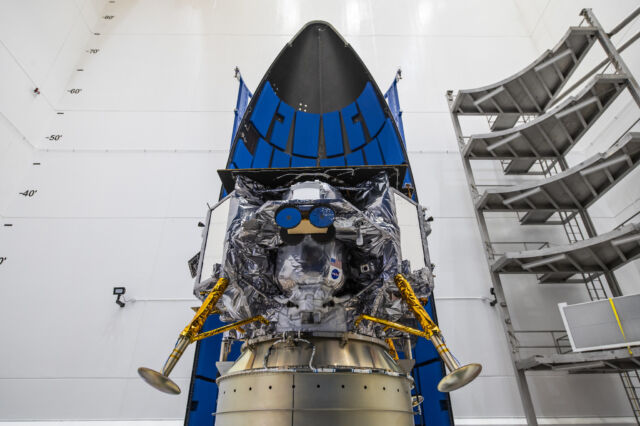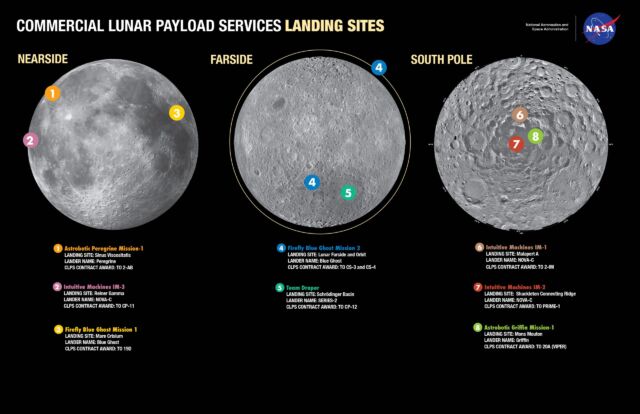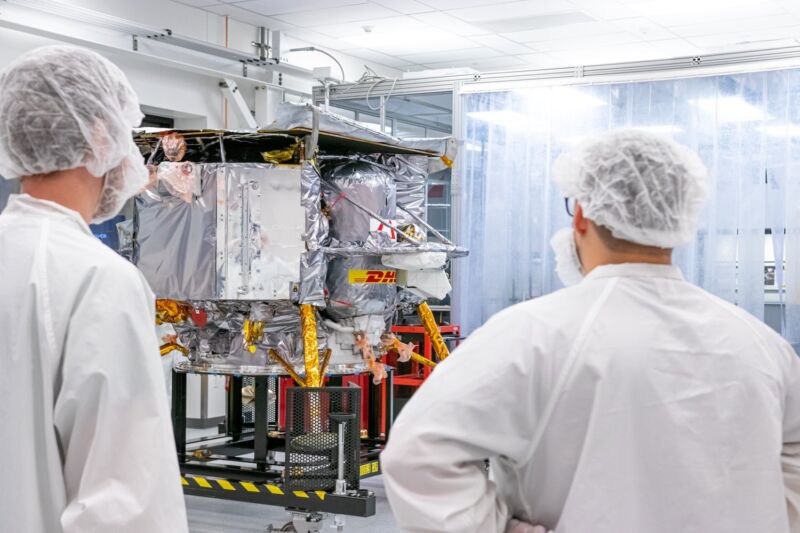A few hours after a successful liftoff on United Launch Alliance's Vulcan rocket, Astrobotic's first commercial lunar lander ran into serious trouble. The robotic Peregrine lander, still in orbit around Earth, appears to have a propellant leak that will prevent it from reaching the Moon.
There are 20 payloads aboard the Peregrine lunar lander, including five from NASA, which is paying Astrobotic about $108 million for delivery of its science instruments to the Moon's surface. Peregrine was the first US-owned lunar lander to launch to the Moon in more than 50 years, and Astrobotic is one of 14 companies selected by NASA to deliver the agency's scientific instruments to the lunar surface.
This program, called Commercial Lunar Payload Services (CLPS), is aimed at flying robotic precursor missions to the Moon before NASA astronauts land on the lunar surface in the agency's Artemis program. Astrobotic's CLPS mission was first to the launch pad.
Propulsion anomaly
Astrobotic's ground controllers, working out of a control center at the company's Pittsburgh headquarters, struggled to stabilize the spacecraft throughout Monday. The problem with the lander's propulsion system initially prevented Peregrine from maneuvering into a Sun-pointing orientation needed to recharge its battery using solar power.
In additional updates, Astrobotic said the propulsion system malfunction would probably threaten the spacecraft's ability to soft-land on the Moon. Engineers uplinked commands for the spacecraft to perform an "improvised maneuver" to reorient its solar panels toward the Sun. That apparently worked, at least temporarily, and Astrobotic reported Peregrine was recharging its battery.
Another statement from Astrobotic released Monday afternoon painted a bleaker picture of the status of Peregrine Mission One.
"Unfortunately, it appears the failure within the propulsion system is causing a critical loss of propellant," the company said. "The team is working to try and stabilize this loss, but given the situation, we have prioritized maximizing the science and data we can capture. We are currently assessing what alternative mission profiles may be feasible at this time."
Astrobotic released an image from the Peregrine lander appearing show a section of distributed multi-layer insulation on the exterior of the spacecraft. This was the "first visual clue" aligning with telemetry data indicating a propulsion system problem, Astrobotic posted on the social media platform X.
"Nonetheless, the spacecraft’s battery is now fully charged, and we are using Peregrine’s existing power to perform as many payload and spacecraft operations as possible," Astrobotic said.
Peregrine's control thrusters are struggling to keep the lander from an uncontrollable tumble, Astrobotic said. If the thrusters hold up to the extra burden, Astrobotic said Monday evening that the lander could remain in a stable Sun-pointing state for about 40 more hours, based on current fuel consumption.
An unmitigated propellant leak would certainly prevent Peregrine from achieving Astrobotic's goal of landing on the Moon. If the mission went according to plan, the Peregrine lander would complete two long phasing loops around Earth before intercepting the Moon and entering lunar orbit in late January. Then, the Peregrine spacecraft would have ignited its main engines for a powered descent to the lunar surface around February 23.
But that's not going to happen for this mission. "At this time, the goal is to get Peregrine as close to lunar distance as we can before it loses the ability to maintain its Sun-pointing position and subsequently loses power," Astrobotic said Monday.
The Peregrine lander's propulsion system uses a hypergolic propellant mixture, combining hydrazine fuel and a solution of nitric oxide and nitrogen tetroxide as the oxidizer. This is a tried-and-true architecture because hydrazine and nitrogen tetroxide immediately combust upon contact with one another, meaning the propulsion system doesn't need an ignition source.
According to Astrobotic, the spacecraft has two tanks each of fuel and oxidizer, plus a fifth tank for helium pressurant. There are five main engines and 12 smaller attitude control engines.
Sharad Bhaskaran, Astrobotic's Peregrine mission director, told Ars before the launch that the design for the lander's propulsion system was "fairly simple and straightforward."
But this was Astrobotic's first space mission, so engineers were eager to learn how the spacecraft operated in orbit. "This is about proving the technology, proving the spacecraft can operate successfully and carry out its mission," Bhaskaran said Friday. “You can do all the testing you want on the ground, and you can do all the simulations, but once you get to space, that's when everything gets proven."
A risky endeavor

Astrobotic's Peregrine lander before launch on ULA's Vulcan rocket.
United Launch Alliance
NASA is going into these CLPS missions, like the Astrobotic lander launched Monday, aware of the risks. A second CLPS mission from a Houston-based company named Intuitive Machines is scheduled to launch in mid-February on a SpaceX Falcon 9 rocket.
“Each success and setback are opportunities to learn and grow," said Joel Kearns, deputy associate administrator for exploration at NASA’s science mission directorate. "We will use this lesson to propel our efforts to advance science, exploration, and commercial development of the Moon."
NASA officials know there was a chance that the first CLPS landing mission could miss the mark. The agency's managers have smartly set low expectations for these early commercial lunar missions, but these first landers are several years late, and a series of failures would inevitably raise questions about the program's future.
Thomas Zurbuchen, who led NASA's science mission directorate for six years, was instrumental in setting up the CLPS program in 2018. Early in the program, Zurbuchen guessed the initial batches of CLPS lander missions might have a 50-50 chance of success. NASA officials watched intently as private ventures like the Israeli Beresheet lunar lander and the Hakuto-R lander from the Japanese company ispace crashed on the Moon. Those missions had no significant NASA involvement, but they were successful until the final stage before landing.
A lander developed by India's space agency also crashed in 2019, but Indian engineers overcame the setback, tried again, and succeeded with a landing in August. Russia's Luna 25 mission also launched in August, but it plummeted to the Moon's surface after a botched engine burn.
China is three-for-three with robotic lunar landers since 2013, a remarkable streak of success that included the first landing on the far side of the Moon and an ambitious mission to return lunar rock samples to Earth.
All told, the world's roster of lunar landers has achieved a 50 percent success rate over the last decade, perfectly in line with Zurbuchen's prediction for the first few CLPS missions. Intuitive Machines needs to be successful with their lunar landing for those 50-50 odds to hold.
But even if Intuitive Machines is unsuccessful, NASA has more CLPS missions on contract. Including Astrobotic's first Peregrine lander, the space agency has awarded nine CLPS mission orders to five companies—eight landings and one lunar orbit mission.
Next steps for CLPS
Astrobotic is developing a larger lunar lander named Griffin to ferry a one-ton NASA rover to the Moon's south pole. This mission, known as VIPER, will search for water ice in dark polar craters, and will cost about $500 million, significantly more than NASA's financial commitment on the Peregrine mission launched Monday.
The commercial approach underpinning CLPS is intended to lower the cost of transporting equipment to the Moon and help foster a stronger market for business activity on the Moon. Astrobotic's Peregrine lander carried privately funded payloads along with NASA science instruments.

This map of the Moon shows the locations of future CLPS missions targeting landings on the near side, far side, and south pole of the Moon.
While one CLPS failure doesn't spell disaster for the program, Zurbuchen said it would be natural for NASA to reassess its assumptions regarding CLPS if the commercial contractors run into multiple setbacks.
“Suppose we’re at the end of ’24, we’ve done multiple landings, and none of them work; I think it’s worth looking at the game. Did it make sense?" Zurbuchen told Ars last year. "I really considered it an experiment when I came up with the idea. Generally speaking, NASA has done well to bet on entrepreneurial entities to do very, very hard challenges.
"Of course, I believe this will be successful. I think it’s really important, come 2025 or so, to really look at the program and say, hey, is it successful? Are there things that NASA should do to affect the program one way or another?"
NASA's payload complement on Astrobotic's Peregrine lander includes a radiation sensor, spectrometers, and a laser retroreflector array. The mission also includes a small lunar rover developed at Carnegie Mellon University and five tiny robots—each less than a tenth of a pound—from the Mexican Space Agency that will deploy onto the lunar surface. Some of Astrobotic's customers are sending commemorative plaques and mementos to the Moon.
NASA officials told reporters before the launch that, in the event Astrobotic's Peregrine mission failed to reach the Moon, the agency would not plan to rebuild any of its instruments aboard the lander. But some of NASA's future CLPS missions are booked to fly similar science payloads to the Moon.
"If this particular mission does not successfully soft land, NASA does not, today, plan to rebuild the instruments and then fly additional copies on future missions, other than what we've already planned today," Kearns said last week.
This story was updated to add a statement from Astrobotic.



3175x175(CURRENT).thumb.jpg.b05acc060982b36f5891ba728e6d953c.jpg)



Recommended Comments
There are no comments to display.
Join the conversation
You can post now and register later. If you have an account, sign in now to post with your account.
Note: Your post will require moderator approval before it will be visible.